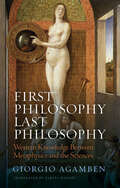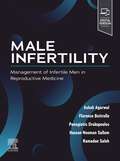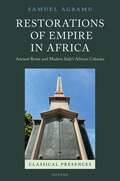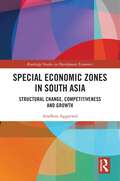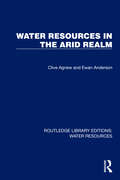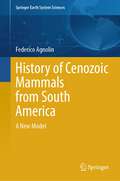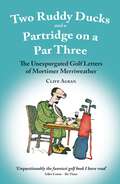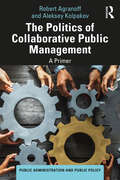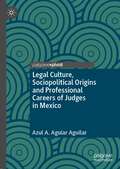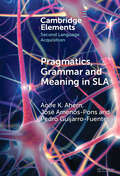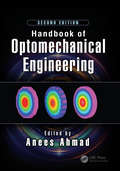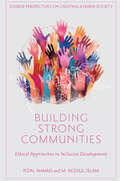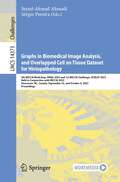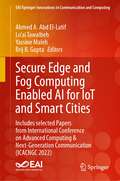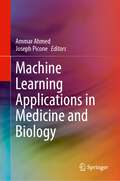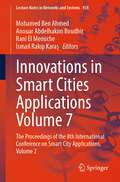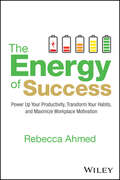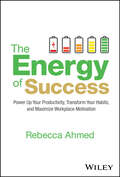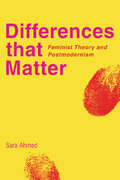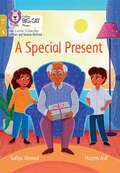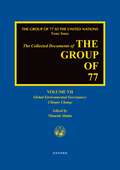- Table View
- List View
First Philosophy Last Philosophy: Western Knowledge between Metaphysics and the Sciences
by Giorgio AgambenWhat is at stake in that form of inquiry that the western philosophical tradition has called “first philosophy” or “metaphysics”? Is it an abstract, now outmoded branch of philosophy, or does it address a problem that is still of great interest – namely the unity of western knowledge? In fact, metaphysics is “first” only in relation to the other two sciences that Aristotle called “theoretical”: the study of nature (phusikē) and mathematics. It is the strategic sense of this “primacy” that needs to be examined, because what is at issue here is nothing less than the relationship – of domination or subservience, conflict or harmony – between philosophy and science. The hypothesis of this book is that philosophy’s attempt to use metaphysics as a way of securing primacy among the sciences has resulted instead in its subservience: philosophy, once handmaiden to theology (ancilla theologiae), has now become more or less consciously handmaiden to the sciences (ancilla scientiarum). So it is all the more urgent to explore the nature and limits of this primacy and subservience, which is what the present book does through an archaeological investigation of metaphysics. This important rereading of the western philosophical tradition by a leading thinker will be of interest to students and scholars in philosophy, critical theory and the humanities more generally, and to anyone interested in contemporary philosophy and European thought.
First Philosophy Last Philosophy: Western Knowledge between Metaphysics and the Sciences
by Giorgio AgambenWhat is at stake in that form of inquiry that the western philosophical tradition has called “first philosophy” or “metaphysics”? Is it an abstract, now outmoded branch of philosophy, or does it address a problem that is still of great interest – namely the unity of western knowledge? In fact, metaphysics is “first” only in relation to the other two sciences that Aristotle called “theoretical”: the study of nature (phusikē) and mathematics. It is the strategic sense of this “primacy” that needs to be examined, because what is at issue here is nothing less than the relationship – of domination or subservience, conflict or harmony – between philosophy and science. The hypothesis of this book is that philosophy’s attempt to use metaphysics as a way of securing primacy among the sciences has resulted instead in its subservience: philosophy, once handmaiden to theology (ancilla theologiae), has now become more or less consciously handmaiden to the sciences (ancilla scientiarum). So it is all the more urgent to explore the nature and limits of this primacy and subservience, which is what the present book does through an archaeological investigation of metaphysics. This important rereading of the western philosophical tradition by a leading thinker will be of interest to students and scholars in philosophy, critical theory and the humanities more generally, and to anyone interested in contemporary philosophy and European thought.
Male Infertility: A Multidisciplinary Approach
by Ashok Agarwal Florence Boitrelle Panagiotis Drakopoulos Hassan Nooman Sallam Ramadan SalehDespite the fact that about half of infertility problems stem from male factors, gynecologists are often the first health care providers to perform the initial assessment of the infertile couple. For this reason, it is critical that gynecologists and reproductive medicine specialists remain up to date on the primary conditions that cause male infertility, as well as current diagnostic tools and treatment options of both natural and assisted conception. From diagnosis through treatment, Male Infertility: Management of Infertile Men in Reproductive Medicine offers expert, straightforward guidance on the pathophysiology and management of male infertility for clinicians who assist couples early in the process of trying to conceive.Covers diagnostic aspects of male infertility (clinical, laboratory, and imaging methods) as well as various therapeutic options including classical and advanced surgical procedures.Discusses intrauterine insemination, conventional in vitro fertilization, intracytoplasmic sperm injection, sperm cryopreservation, preimplantation genetic testing, and more.Begins each chapter with key points and ends with clinical scenarios of real-life problems and their solutions.Shares the knowledge and expertise of global experts in the field.Any additional digital ancillary content may publish up to 6 weeks following the publication date.
Restorations of Empire in Africa: Ancient Rome and Modern Italy's African Colonies (Classical Presences)
by Samuel AgbamuThe histories of Europe and Africa are closely intertwined. At times, this closeness has been emphasized, at other times, suppressed and denied. Since the nineteenth century, European imperial powers have carved up the continent of Africa among themselves, drawing borders and charting shorelines; in the process, inventing Africa. This was a project anchored in ancient Greek and Roman representations of Africa. For Italy, colonialism in Africa was a matter of consolidating its project of national unification, nominally completed in 1870 with the capture of Rome. By asserting its position as an imperial power, the young nation of Italy hoped to join the club of European nation-states and, in so doing, be rid of the perception that it was a country somewhere in between Europe and Africa. Yet, Italy's colonial endeavour in Africa was also a project with deep historical meaning. Italy posed its imperial project in Africa as a national return to territory which was rightfully Italian. Italian ideologues of imperialism based this claim on the history of Roman history on the continent. When Italian soldiers disembarked on the beaches of Libya during Italy's invasion of 1911-1912, and came across the ruins of Roman imperialism, they were, according to prominent cultural and political figures in Italy, rediscovering the traces of their ancestors. Yet, when Italian imperial ambitions set their sights on East Africa, regions that had not been conquered by Rome, how could Italy nevertheless shape its imperial project in the image of ancient Rome? This book charts this story. Beginning with Italy's first imperial endeavours on the African continent in the last decades of the nineteenth century and continuing right through to Italy's current attitudes towards Africa, this book argues that empire in Africa was a central aspect of Italian nation-building, and that this was a project which anchored itself in memories of ancient Rome in Africa. Although Fascism's invasion of Ethiopia (1935-1936) is the best-known moment of Italian imperialism in Africa, this book shows that Italian imperialism, modelled on ancient Rome, has a history which long predates Mussolini's movement, and has a legacy which continues to be acutely felt.
Special Economic Zones in South Asia: Structural Change, Competitiveness and Growth (Routledge Studies in Development Economics)
by Aradhna AggarwalGrowth‑enhancing structural change—a relocation of labour from low‑ to high‑productivity sectors—is increasingly perceived as inextricably linked with the sustainable development agenda. In the pursuit of structural change, policymakers have pinned their hopes on targeted policy tools such as special economic zones (SEZs). These geographically demarcated spaces designed to attract investment with a wide set of advantages have become de rigueur; however, a systematic evaluation of evidence‑informed policymaking is scarce due to conceptual and practical challenges. This book fills that gap and shows that SEZs are no ‘shortcut’ to economic development; their success in driving economic transformation depends on the complex interplay of sociopolitical, economic and strategic factors.This book contributes to the burgeoning literature on SEZs by providing the first systematic evaluation of the SEZ policy. It adopts the ‘policy cycle approach’ to organise policy evaluation into three hierarchical layers: input evaluation (agenda building), output evaluation (policy designs) and outcome evaluation (immediate effects of SEZs on firms’ behaviour and performance) with special reference to South Asian countries. The strategy is to bring together the findings of microeconomic evaluations to draw macro inferences on the contribution of SEZs to the broader objectives of structural transformation and competitiveness. Part I of the book delves into development challenges facing the region, lays out theoretical foundations underlying the relevance of SEZs in addressing them and examines the relevance of SEZs in the context of South Asia. Part II evaluates the policy first at systemic level to gauge whether and how the policy is rooted in broader development goals and then at the design level to examine the fit between the policy goals and designs. Part III presents a counterfactual evaluation of the impact of SEZs on investment climate; export competitiveness of firms; technology and innovation; and knowledge linkages of SEZ firms with the wider economy. The final chapter concludes by discussing the emerging challenges and the way forward.This will be a useful reference for academics, researchers, policymakers and professionals in international trade and business, public policy, industrial economics and regional integration.
Special Economic Zones in South Asia: Structural Change, Competitiveness and Growth (Routledge Studies in Development Economics)
by Aradhna AggarwalGrowth‑enhancing structural change—a relocation of labour from low‑ to high‑productivity sectors—is increasingly perceived as inextricably linked with the sustainable development agenda. In the pursuit of structural change, policymakers have pinned their hopes on targeted policy tools such as special economic zones (SEZs). These geographically demarcated spaces designed to attract investment with a wide set of advantages have become de rigueur; however, a systematic evaluation of evidence‑informed policymaking is scarce due to conceptual and practical challenges. This book fills that gap and shows that SEZs are no ‘shortcut’ to economic development; their success in driving economic transformation depends on the complex interplay of sociopolitical, economic and strategic factors.This book contributes to the burgeoning literature on SEZs by providing the first systematic evaluation of the SEZ policy. It adopts the ‘policy cycle approach’ to organise policy evaluation into three hierarchical layers: input evaluation (agenda building), output evaluation (policy designs) and outcome evaluation (immediate effects of SEZs on firms’ behaviour and performance) with special reference to South Asian countries. The strategy is to bring together the findings of microeconomic evaluations to draw macro inferences on the contribution of SEZs to the broader objectives of structural transformation and competitiveness. Part I of the book delves into development challenges facing the region, lays out theoretical foundations underlying the relevance of SEZs in addressing them and examines the relevance of SEZs in the context of South Asia. Part II evaluates the policy first at systemic level to gauge whether and how the policy is rooted in broader development goals and then at the design level to examine the fit between the policy goals and designs. Part III presents a counterfactual evaluation of the impact of SEZs on investment climate; export competitiveness of firms; technology and innovation; and knowledge linkages of SEZ firms with the wider economy. The final chapter concludes by discussing the emerging challenges and the way forward.This will be a useful reference for academics, researchers, policymakers and professionals in international trade and business, public policy, industrial economics and regional integration.
Water Resources in the Arid Realm (Routledge Library Editions: Water Resources)
by Clive Agnew Ewan AndersonOriginally published in 1992, this book dispels some of the myths that surround water resource problems of arid lands and the notion that there are simple ‘once and for all’ solutions. Population growth, industrialization, environmental mismanagement and land degradation have led to droughts, poverty and famine with the result that the need for space, food and key natural resources such as water has become the most critical issue in global development. Nowhere is this crisis more apparent than in arid lands, where water resources provide the key to economic and environmental development. The authors argue that as the arid land environment is highly variable the key to success is flexibility. The book is divided into four sections, dealing with the geography of the arid realm; the water resource problems they face: the methods available for enhancing water supplies and finally, management of this resource. The book will be of use to undergraduate and postgraduate student and for those actively engaged in the development of arid land water resources.
Water Resources in the Arid Realm (Routledge Library Editions: Water Resources)
by Clive Agnew Ewan AndersonOriginally published in 1992, this book dispels some of the myths that surround water resource problems of arid lands and the notion that there are simple ‘once and for all’ solutions. Population growth, industrialization, environmental mismanagement and land degradation have led to droughts, poverty and famine with the result that the need for space, food and key natural resources such as water has become the most critical issue in global development. Nowhere is this crisis more apparent than in arid lands, where water resources provide the key to economic and environmental development. The authors argue that as the arid land environment is highly variable the key to success is flexibility. The book is divided into four sections, dealing with the geography of the arid realm; the water resource problems they face: the methods available for enhancing water supplies and finally, management of this resource. The book will be of use to undergraduate and postgraduate student and for those actively engaged in the development of arid land water resources.
History of Cenozoic Mammals from South America: A New Model (Springer Earth System Sciences)
by Federico AgnolinThe Cenozoic history of South America faunas mainly rests on the evidence yielded by the study of fossil mammals. Following the seminal work of William D. Matthew, George G. Simpson established the slogan “Splendid Isolation” for describing the evolutionary history of South American faunas. He envisaged South America (as well as other Southern Hemisphere landmasses) as dead ends in the evolution and geographical expansion of animals and plants that since the Mesozoic come in successive migratory waves from the North.More than 40 years passed away from the last important contribution by Simpson (1980). Since then, in spite to the exponential increase in biological, paleontological and geological knowledge, and an incredibly new number of fossils, his scheme remained almost unpolluted and most recent books regarding the palaeobiogeography of South American vertebrates follow this paradigm nearly without criticism.However, the factthat South America was joined to Africa, Australia, Antarctica and India during most of the Cretaceous, and that it was still connected Australia (via Antarctica) and probably Africa up to the Paleogene, together with the large number of shared biotic components between these landmasses, point in favor of a different paleobiogeographical scenario.The book aims to demonstrate that during the Paleogene (and most of the Neogene) the nature and evolutionary history of South American vertebrates is by far much more intricate than previously envisaged. As will be shown, new evidence suggests that southern landmasses may have played an important role in the early evolution and radiation of extant mammal clades. This book is not written to conform with the ideal of a technical manual or a review, and is not carried forward to collect all that has been said before. The main goals are to criticize the current Palaeobiogeographic Model of Vertebrate Settlement of South America, and to propose a new vision based on the evidence provided by the natural world in the last decades.
Two Ruddy Ducks and a Partridge on a Par Three: The Unexpurgated Golf Letters of Mortimer Merriweather
by Clive AgranOnce described as the worst golfer never to have won a major, Mortimer Merriweather is a complex character with virtually nothing to show for 60 years of golf at the lowest level. Decades of abject failure to strike the ball properly undoubtedly fuelled his frustration and led ultimately to him venting his ire on individuals, companies and organisations connected with the game of golf in this remarkable series of 100 letters. The result is this hilarious book of his bizarre, insulting, unsettling and plain mad golfing ideas, all sent to famous hapless recipients, illustrated with occasional cartoons. 'Clive Agran is golf's funniest writer.' – John Hopkins, The Times
The Politics of Collaborative Public Management: A Primer (Public Administration and Public Policy)
by Robert Agranoff Aleksey KolpakovAlthough one often thinks of collaborative management and related group problem-solving as different interests coming together in "peaceful harmony," nothing could be further from reality. Collaboration in real-world action requires steering and negotiation in virtually every situation, with a considerable process that precedes agreement. This progression is, in effect, a "mini" political and managerial process we have come to know as collaborative politics and its management. This volume explores the process and operations of collaboration and collaborative politics, from routine transactions—or "small p" politics—to the significant issue forces, or "big P" politics. Collaboration is defined here as the process of facilitating and operating in multiorganizational arrangements for addressing problems and producing solutions through the contributions of several organizations and individuals. Throughout the book, readers are gradually exposed to analysis of key findings in collaborative politics from the long research tradition in policy and political science. This book adapts a series of stories to highlight some of the dynamics of collaborative politics from a range of jurisdictions. It further analyzes the efficacy of storytelling as a learning tool and contributor to practice in different contexts. With collaborative politics often associated with negotiations among administrative actors, authors Drs. Robert Agranoff and Aleksey Kolpakov demonstrate how interorganizational/interagency collaboration operates and is managed, as well as how it has been modified or adjusted in its fundamental core concepts of bureaucratic organization and hierarchy. The Politics of Collaborative Public Management is designed as a core text for undergraduate and graduate classes on collaborative management and governance.
Legal Culture, Sociopolitical Origins and Professional Careers of Judges in Mexico
by Azul A. Aguiar AguilarThis book explores the careers, professional trajectories and legal cultures of judges in the federal judiciary in Mexico. So far, there has been limited research on internal factors contributing to the understanding of judicial power dynamics in Mexico and other Latin American countries at large; this Work fills an important gap in the literature through its empirical investigation of internal legal cultures and judicial norms, offering new data, measurement strategies,and insights into the interactions between law, politics, norms, legal culture(s), as well as judicial behavior. Utilising an original survey, the chapters analyse judicial conceptualizations of role norms, legal cultures, proclivities for judicial activism, and judicial behavior. In so doing, this book contributes to understanding of underlying key internal factors of judicial activism or restraint, in turn moving forward the debate that seeks to explain judicial behavior reliant on internal and ideational perspectives. Complementing limited but existing studies of judicial politics in Mexico through its analysis of judges beyond those that sit at the Supreme Court, this book will be of particular interest to Latin-American judicial politics scholars due to its focus on the judicial power from internal perspectives as well as sub-national judges, filling a void in the literature vis-à-vis the study of courts in Latin America. This Work was originally written in Spanish, and the translation was done with the help of artificial intelligence. A subsequent human revision was done primarily in terms of content.
Pragmatics, Grammar and Meaning in SLA (Elements in Second Language Acquisition)
by null Aoife K. Ahern null José Amenós-Pons null Pedro Guijarro-FuentesThis Element explores the role of pragmatics, and its relationship with meaning and grammar, in second language acquisition. Specifically, this Element examines the generative paradigm, with its focus on purely linguistic aspects, in contrast with, and complemented by, the view of language adopted in the wider perspective on communication that Relevance Theory offers. It reviews several theoretical standpoints on how linguistic phenomena that require combining semantic, pragmatic and syntactic information are acquired and developed in second languages, illustrating how these perspectives are brought together in analysing data in different linguistic scenarios. It shows that the notion of procedural meaning casts light on the range of interpretative effects of grammatical features and how they vary across languages, suggesting ways to complete the picture of the interface factors that affect second language development.
Handbook of Optomechanical Engineering (Optical Sciences and Applications of Light)
by Anees AhmadThis comprehensive handbook covers all major aspects of optomechanical engineering - from conceptual design to fabrication and integration of complex optical systems. The practical information within is ideal for optical and optomechanical engineers and scientists involved in the design, development and integration of modern optical systems for commercial, space, and military applications. Charts, tables, figures, and photos augment this already impressive text. Fully revised, the new edition includes 4 new chapters: Plastic optics, Optomechanical tolerancing and error budgets, Analysis and design of flexures, and Optomechanical constraint equations.
Building Strong Communities: Ethical Approaches to Inclusive Development (Diverse Perspectives on Creating a Fairer Society)
by Ifzal Ahmad M. Rezaul IslamExploring ethical approaches to inclusive development, Building Strong Communities navigates challenges and strategies, empowering readers to foster resilient, equitable communities in the ever evolving 21st century. Encompassing a wealth of illustrative examples and valuable experiences from different countries around the world, including Canada, Brazil, Sweden, Kenya, China, Australia, Antarctica, India, and more, chapters tackle the mounting necessity for sustainable and equitable development practice. Featuring tools and insights that hold the potential to guide policymakers, practitioners, and scholars alike in the pursuit of nurturing resilient and thriving communities, authors Ifzal Ahmad and M. Rezaul Islam focus on the importance of ethics and inclusivity, offering an interdisciplinary approach, practical frameworks, and impact-driven recommendations for creating thriving communities on a global scale. Illuminating the dynamic interplay between theory and practice, the inclusion of global perspectives showcases the diverse contexts and unique challenges faced by communities around the world, enriching an understanding of community development’s complex landscape. Transcending disciplinary silos and fostering a more comprehensive understanding of community development, Building Strong Communities empowers readers to draw upon multiple perspectives and tools to create meaningful and sustainable change in diverse community contexts and develop holistic solutions that address the interrelated social, economic, environmental, and cultural aspects of community well-being.
Building Strong Communities: Ethical Approaches to Inclusive Development (Diverse Perspectives on Creating a Fairer Society)
by Ifzal Ahmad M. Rezaul IslamExploring ethical approaches to inclusive development, Building Strong Communities navigates challenges and strategies, empowering readers to foster resilient, equitable communities in the ever evolving 21st century. Encompassing a wealth of illustrative examples and valuable experiences from different countries around the world, including Canada, Brazil, Sweden, Kenya, China, Australia, Antarctica, India, and more, chapters tackle the mounting necessity for sustainable and equitable development practice. Featuring tools and insights that hold the potential to guide policymakers, practitioners, and scholars alike in the pursuit of nurturing resilient and thriving communities, authors Ifzal Ahmad and M. Rezaul Islam focus on the importance of ethics and inclusivity, offering an interdisciplinary approach, practical frameworks, and impact-driven recommendations for creating thriving communities on a global scale. Illuminating the dynamic interplay between theory and practice, the inclusion of global perspectives showcases the diverse contexts and unique challenges faced by communities around the world, enriching an understanding of community development’s complex landscape. Transcending disciplinary silos and fostering a more comprehensive understanding of community development, Building Strong Communities empowers readers to draw upon multiple perspectives and tools to create meaningful and sustainable change in diverse community contexts and develop holistic solutions that address the interrelated social, economic, environmental, and cultural aspects of community well-being.
Graphs in Biomedical Image Analysis, and Overlapped Cell on Tissue Dataset for Histopathology: 5th MICCAI Workshop, GRAIL 2023 and 1st MICCAI Challenge, OCELOT 2023, Held in Conjunction with MICCAI 2023, Vancouver, BC, Canada, September 23, and October 4, 2023, Proceedings (Lecture Notes in Computer Science #14373)
by Seyed-Ahmad Ahmadi Sérgio PereiraThis LNCS conference volume constitutes the proceedings of the MICCAI Workshop GRAIL 2023 and MICCAI Challenge OCELOT 2023, Held in Conjunction with MICCAI 2023, Vancouver, BC, Canada, September 23, and October 4, 2023. The 9 full papers (GRAIL 2023) and 6 full papers (OCELOT 2023) included in this volume were carefully reviewed and selected from GRAIL 14 (GRAIL 2023) and 6 (OCELOT 2023) submissions. The conference GRAIL 2023 a wide set of methods and application and OCELOT 2023 focuses on the cover a wide range of methods utilizing tissue information for better cell detection, in the sense of training strategy, model architecture, and especially how to model cell-tissue relationships.
Secure Edge and Fog Computing Enabled AI for IoT and Smart Cities: Includes selected Papers from International Conference on Advanced Computing & Next-Generation Communication (ICACNGC 2022) (EAI/Springer Innovations in Communication and Computing)
by Ahmed A. Abd El-Latif Lo’ai Tawalbeh Yassine Maleh Brij B. GuptaThis book gathers recent research in security and privacy to discuss, evaluate, and improve the novel approaches of data protection in IoT and edge and fog computing. The primary focus of the book addresses security mechanisms in IoT and edge/ fog computing, advanced secure deployments for large scaled edge/ fog computing, and new efficient data security strategy of IoT and edge/ fog computing. The book lays a foundation of the core concepts and principles of IoT and 5G security, walking the reader through the fundamental ideas. This book is aimed at researchers, graduate students, and engineers in the fields of secure IoT and edge/ fog computing. The book also presents selected papers from International Conference on Advanced Computing & Next-Generation Communication (ICACNGC 2022).
Machine Learning Applications in Medicine and Biology
by Ammar Ahmed Joseph PiconeThis book combines selected papers from the 2022 IEEE Signal Processing in Medicine and Biology Symposium (IEEE SPMB) held at Temple University. The symposium presents multidisciplinary research in the life sciences. Topics covered include:Signal and image analysis (EEG, ECG, MRI)Machine learningData mining and classificationBig data resourcesApplications of particular interest at the 2022 symposium included digital pathology, computational biology, and quantum computing. The book features tutorials and examples of successful applications that will appeal to a wide range of professionals and researchers in signal processing, medicine, and biology.
Innovations in Smart Cities Applications Volume 7: The Proceedings of the 8th International Conference on Smart City Applications, Volume 2 (Lecture Notes in Networks and Systems #938)
by Mohamed Ben Ahmed Anouar Abdelhakim Boudhir Rani El Meouche İsmail Rakıp KarașMany cities in the developed world are undergoing a digital revolution, and have placed the "smart city" on their list of priorities. Smart cities use technological solutions such as Internet of Things, AI, 5G, Big Data, Cloud computing, Smart Grid, as well as all the emerging technologies of the digital era, to improve the management and efficiency of the urban environment. The aim is to make residents happier, healthier, smarter and more prosperous, and to make the city greener, cleaner, more sustainable, more responsible, more functional, more resilient, and more competitive. Enhanced by extensive research studies and carried out under the guidance of international scientific experts in the field. This book explores various papers related to smart cities, including digital twins, geo-smart information systems, education, healthcare, economy and digital business, building and home automation, environment and agriculture, and information technologies and computer science.
The Energy of Success: Power Up Your Productivity, Transform Your Habits, and Maximize Workplace Motivation
by Rebecca AhmedIncrease your positive energy at work—and help your team do the same In The Energy of Success, award-winning energy expert Rebecca Ahmed reveals precisely how to shift your physical, emotional, and mental potential through proven, easy-to-use strategies you can start using today. When you learn to shift your own and your team's energy (even if you are not in charge!), you will immediately increase their joy and enthusiasm, transform your workplace, and infuse positivity into your workplace…for everyone. In the book, you'll find five energetic success principles and practical steps you can take immediately to improve your life and the positive influence you can have on the people around you. You'll also discover: Key takeaways to empower others and prepare and control your own personal energy levels at work Critical insights into how you can shift your employees' focus from dwelling on challenges to innovating and communicating solutions Ways to control your responses and reactions to external factors at work, at home, and everywhere else Perfect for employees of all levels, The Energy of Success is a must-read resource for professionals everywhere who hope to change and improve their energy to unlock new levels of success and happiness.
The Energy of Success: Power Up Your Productivity, Transform Your Habits, and Maximize Workplace Motivation
by Rebecca AhmedIncrease your positive energy at work—and help your team do the same In The Energy of Success, award-winning energy expert Rebecca Ahmed reveals precisely how to shift your physical, emotional, and mental potential through proven, easy-to-use strategies you can start using today. When you learn to shift your own and your team's energy (even if you are not in charge!), you will immediately increase their joy and enthusiasm, transform your workplace, and infuse positivity into your workplace…for everyone. In the book, you'll find five energetic success principles and practical steps you can take immediately to improve your life and the positive influence you can have on the people around you. You'll also discover: Key takeaways to empower others and prepare and control your own personal energy levels at work Critical insights into how you can shift your employees' focus from dwelling on challenges to innovating and communicating solutions Ways to control your responses and reactions to external factors at work, at home, and everywhere else Perfect for employees of all levels, The Energy of Success is a must-read resource for professionals everywhere who hope to change and improve their energy to unlock new levels of success and happiness.
Big Cat Phonics for Little Wandle Letters and Sounds Revised – Age 7+ — A SPECIAL PRESENT: Phase 5 Set 5
by Sufiya Ahmed Illustrated by Hazem Asif Prepared for publication by Collins Big CatThe Collected Documents of the Group of 77, Volume VII: Global Environmental Governance: Climate Change
by Mourad AhmiaThis volume features a collection of documents pertaining to the Group of 77's commentary and efforts on global climate governance beginning in the early 1990s and continuing through 2018. It provides a record of the Global South's coordination and joint positions in the climate arena, and its participation in discussions and negotiations at the United Nations, including the UN Framework Convention on Climate Change. Like the previous volumes in the series, Volume VII of The Collected Documents of the Group of 77 at the United Nations offers a unique selection of materials, some of which are unavailable in any other format. Since its founding in 1964, the Group of 77 has worked to provide a voice for developing countries so as to give greater resonance to their shared aspirations. Over almost six decades, the Group of 77 has solidified the Global South as a coalition of nations, aspiring for a global partnership for peace and development. Documenting the Global South's contributions to the ever evolving efforts to combat climate change, The Collected Documents of the Group of 77 Volume VII is a valuable record for diplomats, UN staff, and scholars of public international law and climate governance.
